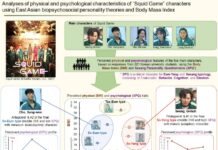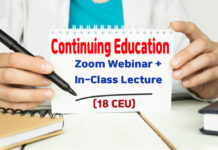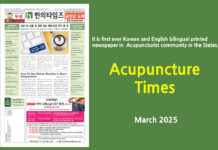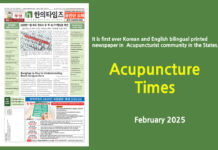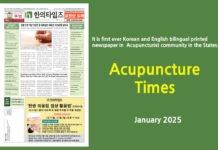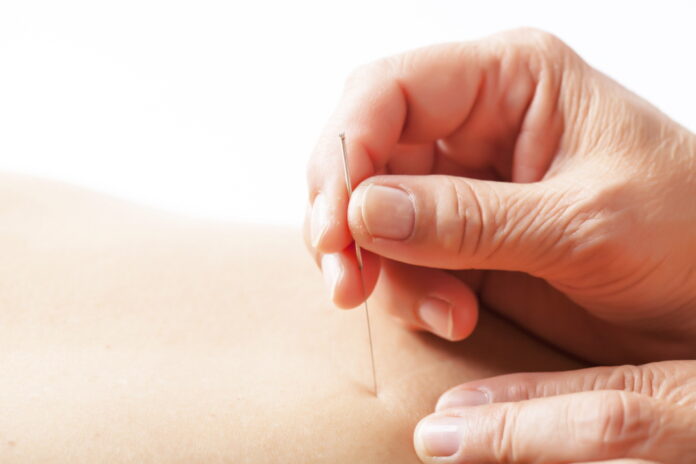By Yong-Suk Kim1, Hyungjoon Jun1, Younbyoung Chae2, Hi-Joon Park3, Bong Hyun Kim4, Il-Moo Chang4, Sung-keel Kang5 and Hye-Jung Lee2
- 1Department of Acupuncture and Moxibustion, College of Oriental Medicine, Kangnam Korean Hospital,
- 2Department of Oriental Medical Science, Graduate School of East-West Medical Science,
- 3Department of Meridian and Acupuncture, College of Korean Medicine, Kyung Hee University,
- 4Natural Products Research Institute, Seoul National University, Seoul, South Korea
- 5Department of Acupuncture and Moxibustion, College of Oriental Medicine, Kyung Hee University, South Korea
Introduction
Acupuncture, one of the Oriental medical therapeutic techniques inherited from ancient East Asia, is gaining popularity in the West as an alternative and complementary therapeutic intervention (1). Acupuncture is now being used in Western medicine to treat postoperative-induced and chemotherapy induced nausea and vomiting, postoperative dental pain, drug addiction, stroke rehabilitation and asthma (2). Korea has continued to develop its own unique traditional medicine throughout its long history, and has formed different types of acupuncture methods, apart from those of traditional Chinese medicine. An individualized approach based on constitutional energy traits and practical approaches applying new therapeutic modalities have been developed for treatment of disorders (3).
A large number of clinical studies using acupuncture have been performed to demonstrate its efficacy for many kinds of diseases, such as pain (headache, facial pain, neck pain, shoulder pain, lower back pain and knee pain), stroke, facial palsy
and other diseases in Korea. A wide range of control groups were used in these studies. Acupuncture and acupuncture related
therapies have been compared with various forms of control acupuncture, standard care, no treatment, baseline conditions and placebo acupuncture. These inconsistencies make the task of designing and performing systematic reviews or meta-analyses more difficult. However, non-controlled clinical trials might also be useful for the overview that they provide of what is known so far, with data that may inform future research. This review is an attempt to show a variety of applications for acupuncture treatments performed by the traditional Korean medical sector.
Clinical Studies Using Acupuncture Treatment in Korea
Acupuncture for Pain Headache
Lee and Kim (4) analyzed the effect of acupuncture treatment at trigger points in 27 patients with headache. Lee et al. (5)
compared the effect of acupuncture at trigger points with the effect of acupuncture at remote acupuncture points in patients
who were diagnosed as having tension-type headaches. A clinical study of auricular acupuncture was also done in 55 patients
with headaches (6). Clinical studies of acupuncture and auricular acupuncture for tension-type headaches were also performed (7,8) (Table 1).

Facial Pain
Temporomandibular disorder (TMD) is a musculoskeletal problem of the masticatory system and is quite commonly treated by acupuncture in the general population. It was reported that 8 and 10 cases, respectively, of TMD were treated by acupuncture (9,10). Wang et al. (11) treated by Dong-Qi acupuncture and subjectively evaluated TMD and facial pain (Table 2).

Neck Pain
Chun and Lee (12) treated patients with chronic neck pain by using electric acupuncture (0.3 · 40 mm, 3.5–12 Hz, 9 V). Kim and Lee (13) compared the group treated by both acupuncture and manipulation (chuna) treatment with the group only treated by acupuncture. A clinical study investigated the clinical applications of Oriental medical therapies including acupuncture treatment together with herbal therapy and hot pack for patients complaining of cervical pain caused by traffic accidents (14). It was reported that acupuncture treatment was effective in 50 patients with cervical pain (15). Lee and Lee
(16) treated 25 patients with neck pain with electric acupuncture together with herbal therapy, cupping therapy and hot pack. It was also reported that acupuncture was effective in treating 50 patients with herniated cervical disc (17) (Table 3).

Shoulder Pain
Forty-three patients suffering from frozen shoulder during physical exercise were treated by acupuncture, moxibustion and electric acupuncture, and evaluated with Apley scratch test. A total of 16.3% of them reported that the results of treatment
were excellent and 30.2% of them reported that they were good (18). Cho and Lee (19) showed the correlation between digital infrared thermography image (DITI) data and changes in clinical symptoms after acupuncture treatment in patients with frozen shoulder (Table 4) (Fig. 1).


Low Back Pain
A series of 20 cases with lumbar herniated disc disease were treated by acupuncture (20). It was reported that acupuncture
and herbal medicine alleviated the symptoms of the herniation of lumbar intervertebral disc (21–25). It was also reported that
bee venom acupuncture (BVA) was beneficial for treating herniated intervertebral disc (HIVD) (26). Park et al. (27) performed
clinical studies using acupuncture and manipulation treatment on 30 HIVD patients. It was found that microcurrent electrical neuromuscular stimulation was significantly effective in decreasing the visual analog scores of patients with lower back pain (28). Park et al. (29) reported a clinical study of the stability of the lumbosacral angle of 69 patients suffering from lower back pain. The morphological changes were demonstrated by computed tomographic scan examination of acute HIVD patients who underwent Oriental medical treatment (30).
A clinical study compared acupuncture with electric acupuncture for patients with HIVD (31). Park and Lee (32) compared the effect of electric acupuncture with the effect of Dong-si acupuncture on patients with HIVD. Lee and Hwang (33) compared electric acupuncture with electric acupuncture and Saam acupuncture in HIVD patients. Yoon et al. (34) compared acupuncture at A-shi points with acupuncture on acupuncture points in HIVD patients. Chae et al. (35) compared conventional acupuncture with Eight constitution acupuncture and demonstrated that Eight constitutional acupuncture was more beneficial than conventional acupuncture for the treatment of HIVD patients.
Electric acupuncture decreased the frequency of radiating pain in lumbar spondylosis (36). Clinical studies evaluated Oriental medical treatment and manipulation therapy in patients with scoliosis (37,38). Kim (39) reported the results of 96 patients suffering from sciatica with lower back pain treated by acupuncture and herbal medicine. It was reported that acupuncture, moxibustion and herbal medicine were useful for acute back pain (40). Lee and Yin (41) also reported a clinical study of BVA on ankylosing spondylitis. Lee et al. (42) performed a clinical study on acupuncture for stable thoracolumbar vertebral fractures. It was reported that acupuncture, electric acupuncture, acupuncture at Hua-Tuo-Jia-Ji-Xue were useful for the treatment of thoracolumbar compression fracture (43–45). Han (46) treated degenerated stenosis patients (37 cases), and Kim et al. (47) evaluated the clinical results of the spondylolisthesis patients treated by Oriental medical methods.
Lee et al. evaluated acupuncture treatment for HIVD and stable compression fracture patients using DITI (48,49). Cho and Kim (50) compared the acupuncture with electric acupuncture for HIVD patients using DITI. Hur et al. (51) investigated changes in the clinical symptoms of patients with spondylolisthesis after acupuncture treatment and evaluated alterations in DITI. A clinical study also reported a relationship between cigarette smoking and the result of Oriental medical treatment for lower back pain (52). Heo and coworkers studied the treatment of lower back pain and sciatica and found some correlation in the rate of alleviation with alterations in Moire topography (53,54) (Table 5).
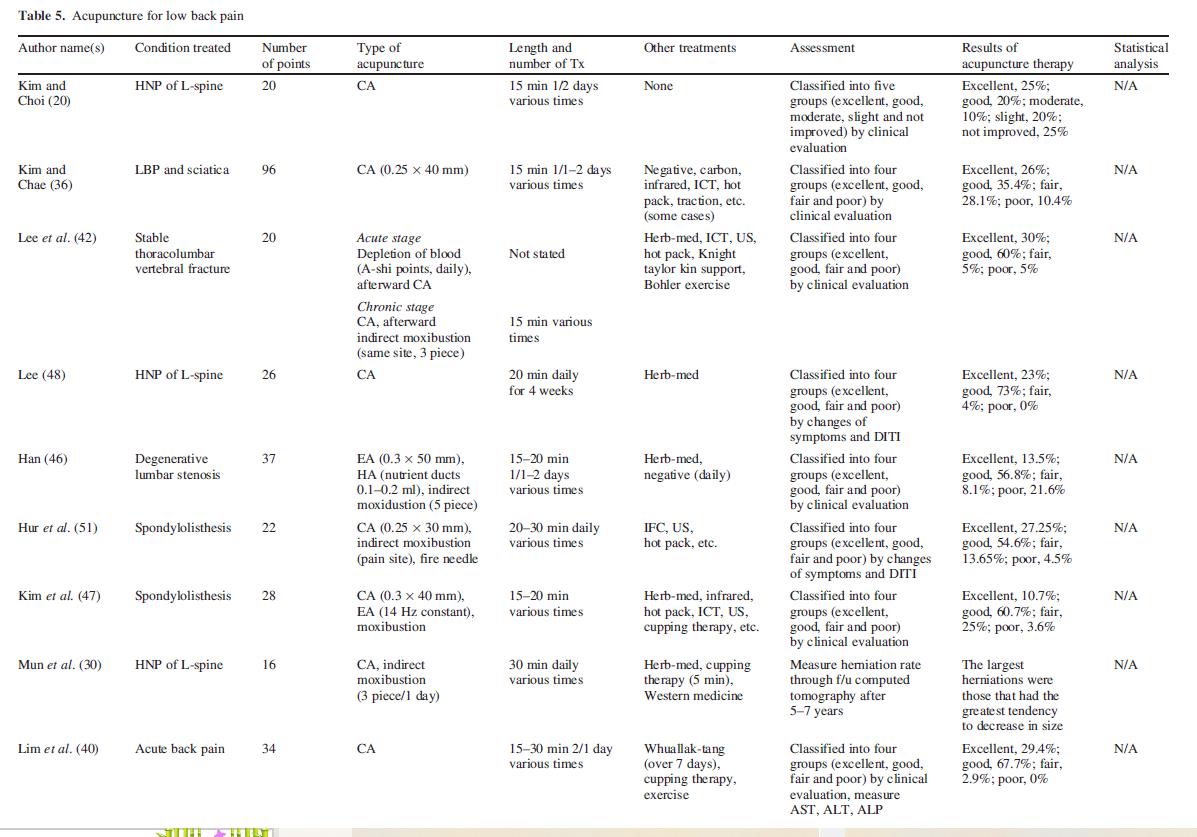
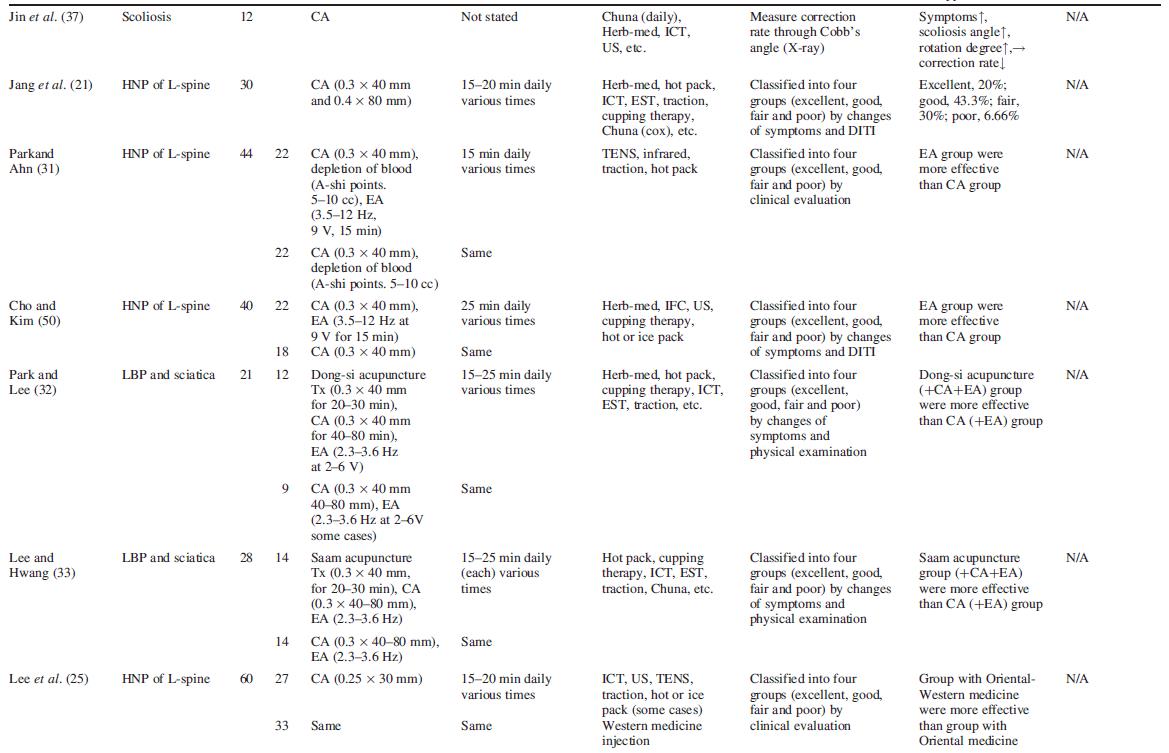
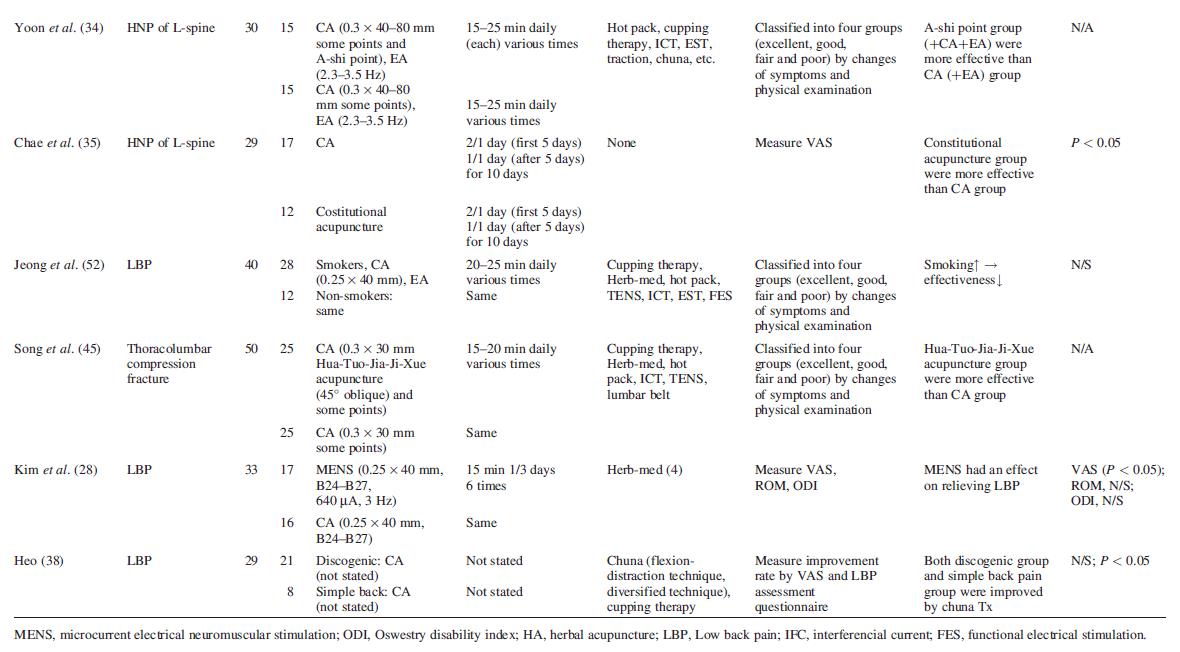
Knee Joint Pain
It was reported that acupuncture was useful for the treatment of degenerative arthritis of knee joints (55–57). Woo et al. (58)
evaluated the clinical effect of acupuncture on microtraumatic injuries of the knee joint. Kim and Lee compared acupuncture
with BVA for osteoarthritis (59,60). Hwang et al. (61) measured the change of C-reactive protein (CRP), erythrocyte sedimentation rate (ESR) and rheumatoid arthritis (RA) factor, and the satisfactory assessment after BVA treatment in RA
patients. Hwang (62) treated RA patients with herbal acupuncture (HA) and evaluated CRP, ESR, RA factor and immunoglobulin
G and M (Table 6).

Other Painful Diseases
Electrical acupuncture stimulation was very useful to relieve pain that had not responded to various conventional medications
including nerve blocks, neurosurgical intervention and neuropolitics (63). Cho et al. (64) compared acupuncture treatment and analgesics in postthoracotomy pain control. It was reported that venesection, a therapeutic method of sucking out non-physiological blood, alleviated pain induced by blood circulation dysfunction (65). Kim et al. (66) compared acupuncture treatment with trigger point treatment in ankle sprain patients. Bang et al. (67) carried out a clinical study on patients with humeral lateral epicondylitis or tennis elbow. Seung and Ahn (68) investigated the effect of moxibustion on the immune
activity in the treatment of patients. Acupuncture treatment was very beneficial for acute gout (69). It was also demonstrated
that acupuncture at acupoints on the non-injured side were as effective as acupuncture at acupoints on the injured side in ankle sprain patients (70) (Table 7) (Fig. 2).


References
- 1. Eisenberg DM, Davis RB, Ettner SL, Appel S, Wilkey S, Van Rompay M, et al. Trends in alternative medicine use in the United States, 1990–1997: results of a follow-up national survey. J Am Med Assoc 1998;280: 1569–75.
- 2. Panel NCD. NIH Consensus Development Panel. Acupuncture. J Am Med Assoc 1998;280:1518–24.
- 3. Yin CS, Park HJ, Chae YB, Ha EY, Park HK, Lee HS, Koh HG, Kang SG, Choi SM, Ryu YH, Lee HJ. Gnuine Korean Acupuncture: The individualized and practical approach. Neurol Res 2005: (submitted for publication).
- 4. Lee SY, Kim JH. The clinical observation of patient with headache treated by trigger point acupuncture therapy. J Oriental Pediatr Soc 1998;12:133–43.
- 5. Lee SM, Hwang KS, Han HC, Jeong HS. Clinical study of different effect between trigger point needling and remote acupuncture point needing on tension-type headache. J Kor Acu Mox Soc 2001;18:14–20.
- 6. Byun JY, Ahn SG. A clinical research of the auricular acupuncture therapy on headache. J Kor Acu Mox Soc 1995;12:355–63.
- 7. Kim YS, Kim SH. A clinical review on the effect of acupuncture (body and ears) treatment for strained headache. J Kor Oriental Med Soc 1996;17:433–46.
- 8. Kim JH, Lee JD, Choi DY, Ahn BC, Park DS, Lee YH. Clinical study of acupuncture effect on chronic headache. J Kor Acu Mox Soc 2000;17:1–9.
- 9. Kim YS, Kim CH. Eight cases of temporomanidular disorder. J Kor Acu Mox Soc 1996;13:429–35.
10. Byun JY, Ahn SG, Lee BC. Clinical study on the patients with temporomandibular disorders. J Kor Acu Mox Soc 1999;16:61–7. - 11. Wang WH, Lim JK, Ahn KB, Jang HS, Shin JS. Clinical observation of temporomandibular disorder patients used Dong-Qi acupuncture treatment. J Kor Acu Mox Soc 2001;18:109–21.
- 12. Chun JK, Lee HI. Clinical study of painful neck disease. J East-West Med 1998;23:31–47.
- 13. Kim KO, Lee JS. The clinical effects of chuna treatment in painful neck disease. J Kor Manual Med 2000;1:67–82.
- 14. Choi SH, Oh MS, Song TW. Clinical studies on 52 cases of patient with cervical pain caused by traffic accident. J Oriental Rehabil Med 2000;10:45–55.
- 15. Lee BR, Lee H, Park TG. Clinical studies on 50 cases of patient with cervical pain. J Kor Acu Mox Soc 1999;16:69–82.
- 16. Lee EY, Lee BR. A clinical observation for 25 cases of patients who are taken by chiefly complained of neck pain. J Kor Acu Mox Soc 1998;15:393–406.
- 17. Lee GM, Kim KS, Um TS, Shin YM. A clinical study on the effects of the therapy of acupuncture on herniated cervical disc. J Kor Oriental Med Soc 1989;10:54–72.
- 18. Park SY, Lee BR. A clinical observation for the patients who are taken by frozen shoulder with the physical exercise problem. J Kor Acu Mox Soc 1999;16:17–25.
- 19. Cho HB, Lee GM. Clinical evaluation of acupuncture on frozen shoulder by DITI. J Kor Acu Mox Soc 1999;16:387–94.
- 20. Kim JK, Choi YT. Clinical study on the effect of acupuncture treatment for herniation on lumbar intervertebral disc. Kyunghee Med 1988;4:425–31.
- 21. Jang SG, Hwang KJ, Lee H, Lee BR. Clinical reports on correlation between the different herniated type and oriental medical treatment. J Kor Acu Mox Soc 2001;18:68–81.
- 22. Park SY, Lee BR. A clinical observation in herniation of lumbar intervertebral disc on plain lumbar CT. J Kor Acu Mox Soc 1998;15:69–79.
- 23. Park SJ, Cho MR, Kim CS. Clinical study on 100 patient of low back pain. J Kor Acu Mox Soc 1999;16:119–35.
- 24. Byun JY, Lee JD. Clinical study on the conservative treatment in the different types of herniated lumbar intervertebral disc. Kor Int Med Soc 1998;15:55–64.
- 25. Lee GM, Lee KC, Hwang YJ. Collaborative study of oriental-western medicine on HIVD. J Kor Acu Mox Soc 2000;17:1–10.
- 26. Kim JH, Lee JD. Assessment of bee venom acupuncture effect in herniated disc patient by rating scale. J Kor Oriental Med Soc 1999;20:200–7.
- 27. Park TK, Lee YK, Lee BR. The clinical studies on 30 cases of patient with HNP by chuna treatment and analysis based on toes and foot shape. J Kor Acu Mox Soc 1999;16:27–39.
- 28. Kim HJ, Chung SH, Lee JS, Kim SS, Shin HD. The effect of microcurrent electrical neuromuscular stimulation on low back pain. J Oriental Rehabil Med 2001;11:1–14.
- 29. Park KW, Lee H, Lee BR. The clinical study on the stability of the lumbosacral angle of the patient suffering from low back pain. J Kor Acu Mox Soc 1999;16:41–55.
- 30. Mun HC, Hwang WJ, Lee GM, Cho NG, Gang SD, Cho JW, et al. The disc morphological changes on CT scan examinations after 5–7 years of acute HIVD patients who underwent oriental medical treatment. J Kor Acu Mox Soc 2001;18:1–12.
- 31. Park SY, Ahn SG. Comparative study between acupuncture and electroacupuncture on herniated intervetebral disc patients. J Kor Acu Mox Soc 1995;12:273–82.
- 32. Park HS, Lee BR. The clinical study on the efficacy of the Dong-si acupuncture treatement. J Kor Acu Mox Soc 1997;14:15–34.
- 33. Lee H, Hwang WJ. The clinical study of the efficacy of the Sa-am acupuncture treatment. J Kor Acu Mox Soc 1999;16:1–16.
- 34. Yoon KB, Cho M, Jung H. The clinical study on the efficacy of the Ashi point. J Kor Acu Mox Soc 2001;18:226–36.
- 35. Chae SJ, Kim NO, Park YC, Son SS. Comparison of the improvement of subjective symptoms between body acupuncture group and eight constitution acupuncture group. J Kor Acu Mox Soc 2001;18:48–55.
- 36. Kim YS, Chae YS. Clinical studies on the effect of the electrical acupuncture stimulation therapy of low back pain in lumbar spondylosis. J Kor Oriental Med Soc 1989;10:113–28.
- 37. Jin JD, Lee JH, Lee SW, Seo JC, Han SW. A clinical study on patients of scoliosis. J Kor Acu Mox Soc 2001;18:11–23.
- 38. Heo SY. A clinical study on the outcome of chuna treatment of structural scoliosis by 25 cases. J East-West Med 1999;24:1–17.
- 39. Kim GM. Clinical studies on sciatica with low back pain. J Kor Oriental Med Soc 1992;9:88–100.
- 40. Lim JE, Song HS, Kwon SJ, Lee SN, Kang MS, Byun IJ, et al. A clinical study of the effects of acupuncture, moxibustion and Whuallak-tang (Huoluo-tang) on acute back pain and liver function. J Kor Acu Mox Soc 2001;18:43–9.
- 41. Lee SK, Yin CS. Clinical study of bee venom acupuncture therapy on ankylosing spondylitis. J Kor Inst Herbal Acu 1999;2:39–49.
- 42. Lee GM, Seong NG, Chae YS. Clinical study of stable thorarcolumbar vertebral fractures. J Kor Oriental Med Soc 1993;14:339–52.
- 43. Lee JG, Lee BR. The clinical study on 32 cases of patient with thoracolumbar compression fracture. J Kor Acu Mox Soc 1998;15:427–36.
- 44. Lim JE, Kim KH, Hwang HS. The clinical study on 44 cases of patient with thoracolumbar compression fracture. J Kor Acu Mox Soc 2000;17:41–51.
- 45. Song WS, Hwang JY, Shin YI, Lee BR. The clinical study on Huatuojiajixue acupuncture treatment of patient with thoracolumbar compression fracture. J Kor Acu Mox Soc 2001;18:55–67.
- 46. Han SW. Oriental medical treatment of degenerative lumbar stenosis. J Kor Acu Mox Soc 1995;12:351–9.
- 47. Kim HJ, Lee SR, Byun JY, Ahn SG. Clinical study of the treatment of spondylolisthesis. J Kor Acu Mox Soc 2000;17:106–15.
- 48. Lee GM. Clinical evaluation acupuncture treatment on herniated intervertebral disc by digital infrared thermographic image. J Kor Acu Mox Soc 1994;11:275–82.
- 49. Lee GM, Lee SJ, Lee BC. Clinical evaluation of oriental medicine treatment of stable compression fracture by DITI. J Kor Acu Mox Soc 1997;14:9–20.
- 50. Cho NG, Kim KS. Comparative study between electroacupuncture and acupuncture on herniated intervertebral disc by using digital infrared thermographic image. J Kor Acu Mox Soc 1997;14:21–30.
- 51. Hur TY, Cho NG, Cho EH, Cheon MN. Clinical evaluation of acupuncture on spondylolisthesis by DITI. J Kor Acu Mox Soc 2000;17:31–9.
- 52. Jeong SH, Kim SJ, Lee EY. The clinical study of the association between cigarette smoking and effect of oriental medical treatment in low back pain. J Kor Acu Mox Soc 2001;18:32–45.
- 53. Heo SY, Kim KH. Investigation on the correlation improvement rate of symptoms with Moire topography analytic improvement rate. J Kor Manual Med 2000;1:55–65.
- 54. Heo SY, Kang HS. Investigation on chuna treatment for low back pain and sciatica. J East-West Med 1999;24:14–26.
- 55. Lee GM, Seong NG. A clinical study of the effects of the therapy on knee joints with osteoarthritis. J Kor Oriental Med Soc 1991;12:147–59.
- 56. Koh KS, Kang SK. Clinical observation on degenerative arthritis of knee joint. J Kor Oriental Med Soc 1987;8:66–72.
- 57. Na CS, Ahn BC. A clinical study on degenerative arthritis of knee joint. J Kor Oriental Med Soc 1992;13:202–11.
- 58. Woo YM, Lee JH, Kim JM, Nam Y. Clinical study of acupucnture effect on microtraumatic injuries of the knee joint. J Kor Acu Mox Soc 2000;17: 88–99.
- 59. Wang WH, Ahn KB, Lim JK, Jang HS. Clinical investigation compared with the effects of the bee venom acupuncture on knee joint with osteoarthritis. J Kor Acu Mox Soc 2001;18:35–47.
- 60. Kim JH, Lee JD. Clinical research of bee venom acupuncture analgesic effect on osteoarthritis. J Kor Acu Mox Soc 1999;16:25–37.
- 61. Hwang YJ, Lee GM, Hwang WJ, Seo EM, Jang JD, Yang GB, et al. Clinical research of bee venom acupuncture effects on rheumatoid arthritis. J Kor Acu Mox Soc 2001;18:33–42.
- 62. Hwang WJ. Clinical study of rheumatoid arthritis. J Kor Acu Mox Soc 1995;12:281–90.
- 63. Shim JC, Kim YJ, Suh JK, Chung CW, Kang GB, Hwang YH, et al. Clinical study of electrical stimulation of the peripheral nerve. J Kor Soc Anesth 1984;17:126–35.
- 64. Cho KS, Kim SC, Lee JY, Sohn SS, Park DS. The effect of acupuncture on the post-thoracotomy pain control. Kor J Thorac Cardiovasc Surg 1997;30:187–94.
- 65. Choi H, Moon SJ. A clinical study on reviewing pain of acupuncture. J Kor Acu Mox Soc 1983;1:40–5.
- 66. Kim YI, Kim YH, Lee H, Lee BR. Clinical comparison studies on 26 cases of patient with ankle sprain with acupuncture treatment group and trigger point treatment group. J Kor Acu Mox Soc 2001;18: 50–9.
- 67. Bang DH, Chang HS, Han SW, Ryu SH, Lee IG. A clinical observation of patients with humeral lateral epicondylitits. J Kor Oriental Med Soc 1992;13:224–9.
- 68. Seung JW, Ahn CB. A study on human immune activity of the arthritis and multi-neuritis through different moxibustion methods. J Kor Acu Mox Soc 1991;8:395–403.
- 69. Choi YT, Lee HJ. A study of acupuncture treatment effect on the acute gout disease. J Kor Oriental Med Soc 1989;10:132–7.
- 70. Ahn KB, Wang WH, Lim JK, Jang HS. Clinical study of acupuncture effect by measuring amperage from chong points. J Kor Acu Mox Soc 2001;18:13–21.



